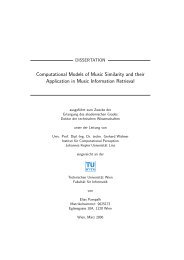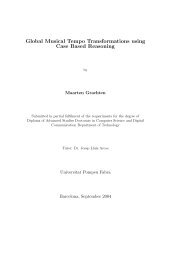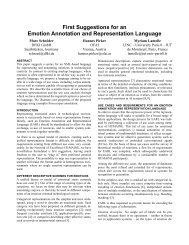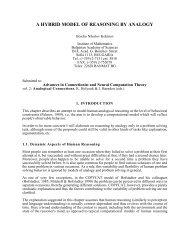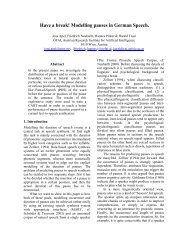Convergent Decomposition Solvers for Tree-reweighted Free ... - OFAI
Convergent Decomposition Solvers for Tree-reweighted Free ... - OFAI
Convergent Decomposition Solvers for Tree-reweighted Free ... - OFAI
You also want an ePaper? Increase the reach of your titles
YUMPU automatically turns print PDFs into web optimized ePapers that Google loves.
<strong>Convergent</strong> <strong>Decomposition</strong> <strong>Solvers</strong> <strong>for</strong> <strong>Tree</strong>-<strong>reweighted</strong> <strong>Free</strong> Energies<br />
Table 1: Impact of the set of spanning trees on the approximation error<br />
Grid IsingGauss Grid IsingUni<strong>for</strong>m Regular IsingGauss Complete ExpGauss<br />
e( ˜Φ) e(µ) e( ˜Φ) e(µ) e( ˜Φ) e(µ) e( ˜Φ) e(µ)<br />
4Snakes 0.085 ± 0.01 0.112 ± 0.01 0.104 ± 0.01 0.087 ± 0.00 ∼ ∼<br />
Minimal 0.088 ± 0.01 0.113 ± 0.01 0.109 ± 0.01 0.090 ± 0.00 0.833 ± 0.10 0.308 ± 0.05 0.397 ± 0.07 0.074 ± 0.01<br />
Uni<strong>for</strong>m 0.084 ± 0.01 0.110 ± 0.01 0.102 ± 0.01 0.085 ± 0.00 0.833 ± 0.10 0.308 ± 0.05 0.394 ± 0.07 0.074 ± 0.01<br />
⋆ Uni<strong>for</strong>m 0.083 ± 0.01 0.110 ± 0.01 0.101 ± 0.01 0.085 ± 0.00 0.833 ± 0.10 0.308 ± 0.05 0.394 ± 0.07 0.074 ± 0.01<br />
Optimal 0.031 ± 0.01 0.091 ± 0.02 0.053 ± 0.01 0.079 ± 0.01 0.832 ± 0.10 0.308 ± 0.05 0.377 ± 0.07 0.075 ± 0.01<br />
4 EXPERIMENTS<br />
We wanted to assess several aspects of our algorithms<br />
empirically. Towards this end, we considered four<br />
types of random graphs that varied with respect to<br />
their structure and the exponential parameters θ. 2<br />
Grid IsingGauss: an n g × n g grid of binary variables<br />
(X = {−1, +1}), with potentials chosen as<br />
θ s (x s ) = θx s and θ st (x st ) = θx s x t , where θ ∼ N (0, 1)<br />
was drawn independently <strong>for</strong> each node and edge.<br />
Grid IsingUni<strong>for</strong>m: Equal to the above, except that<br />
θ was drawn from U(−1, +1).<br />
Regular IsingGauss: A random regular graph with<br />
n r binary variables, each of which was connected to n d<br />
others, and potentials akin to Grid IsingGauss.<br />
Complete ExpGauss: A complete graph with n c<br />
variables (X = {0, 1, 2, 3}) and potentials independently<br />
drawn as θ s (x s ) = 0 and θ st (x st ) ∼ N (0, 1).<br />
4.1 IMPACT OF TREE SELECTION<br />
We considered four different ways of decomposing the<br />
cyclic graphs into spanning trees: 4Snakes, described<br />
in section 3.5.2; Minimal, described in section 3.5.3;<br />
Uni<strong>for</strong>m described in section 3.5.1; and finally Optimal<br />
(section 3.5.4). For the Uni<strong>for</strong>m decomposition,<br />
we stopped once min (s,t) ν st ≥ 0.9 max (s,t) ν st . The<br />
4Snakes decomposition was only applicable to grids.<br />
First, we wanted to assess the impact of the decomposition<br />
scheme on the approximation errors e( ˜Φ) =<br />
| ˜Φ − Φ(θ)|/Φ(θ) and e(µ) = ‖µ − E{φ(x)}‖ 1 /d. We<br />
generated 30 instances of each type of graph considered<br />
(with n g = 15, n r = 30, n d = 10 and n c = 10)<br />
and solved the corresponding instance of (6) to a tolerance<br />
of ε = 10 −5 using Algorithm 1. For the Optimal<br />
scheme, we used 50 outer iterations. The gains<br />
were minuscule beyond this point. The reference values<br />
Φ(θ) and E{φ(x)} were computed using join trees<br />
or brute <strong>for</strong>ce, depending on the type of graph.<br />
Table 1 shows the average and the standard deviation<br />
(indicated using ±) of the error over the 30 instances<br />
2 We used libDAI (Mooij, 2010) to generate instances.<br />
Table 2: Standard deviation of the approximation error<br />
<strong>for</strong> 30 runs over the same graphs and potentials, using<br />
different Minimal sets of trees at each run.<br />
e( ˜Φ) e(µ)<br />
Grid IsingGauss 0.096 ± 0.0018 0.113 ± 0.0012<br />
Grid IsingUni<strong>for</strong>m 0.112 ± 0.0019 0.090 ± 0.0010<br />
Regular IsingGauss 0.866 ± 0.0003 0.351 ± 0.0002<br />
Complete ExpGauss 0.355 ± 0.0023 0.076 ± 0.0004<br />
of each type of graph. The tree decomposition was<br />
computed anew <strong>for</strong> each instance. Unsurprisingly, the<br />
Optimal scheme per<strong>for</strong>med best almost universally,<br />
with large gains in some instances. More interestingly,<br />
the other three schemes were rather closely tied, with<br />
only a slight edge <strong>for</strong> the Uni<strong>for</strong>m decomposition.<br />
For comparison, we also computed the approximation<br />
errors resulting from analytically determined uni<strong>for</strong>m<br />
edge probabilities ( ⋆ Uni<strong>for</strong>m), which corresponds to<br />
an infinite number of iterations of Algorithm 2; the<br />
gains over the Uni<strong>for</strong>m scheme are negligible. Finally,<br />
we checked how deterministically the Minimal<br />
scheme behaved on a single given graph (considering<br />
its random nature). Table 2 shows that the deviation<br />
over 30 independent decompositions was very low.<br />
4.2 EFFECTIVENESS OF SOLVERS<br />
In a second series of experiments, we compared our<br />
own solvers (TrwSPG, outlined by Algorithm 1, and<br />
TrwPQN with p = 4) to the message passing algorithm<br />
(TrwMP) of Wainwright et al. (2005a) and<br />
a variant thereof (TrwDMP) that employs “damping”<br />
(α = 0.5). In our implementation of the latter,<br />
we updated the messages by iterating over the edges<br />
uni<strong>for</strong>mly at random. For comparison, we used the<br />
same types of graphs as in section 4.1, with n g = 50,<br />
n r = 100, n d = 10 and n c = 50.<br />
4.2.1 Asymptotic Efficiency<br />
First, we compared the asymptotic behavior of the<br />
competing solvers. To this end, we ran them on the<br />
same randomly generated instances of each type of<br />
graph. Figure 2 shows the progress of the objective<br />
as a function of iterations of the respective algorithm.<br />
The plot displays only a single run of each solver




